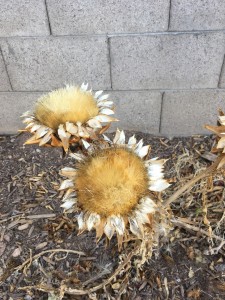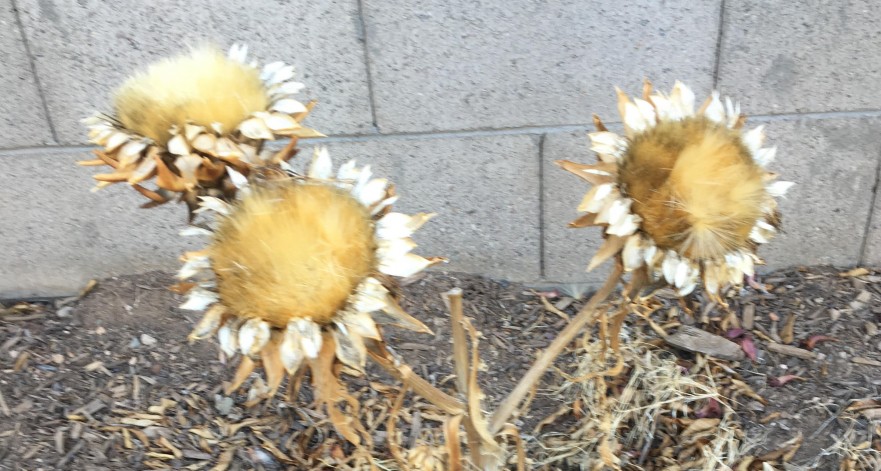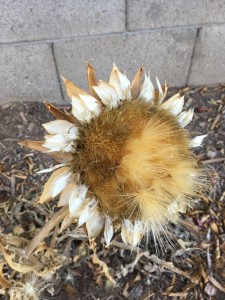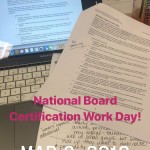The weather was gorgeous over the long holiday weekend, mid-80’s, and clear with a light breeze. I finished painting our chicken enclosure, disentangled armfuls of the overgrown bermuda grass from the asparagus patch, and peered at the hopeful sprouts of kale, snap peas and cilantro that the chickens haven’t managed to dig up yet. Along our back cinder block wall (the “heat wall” as I think of it– I have tried planting various things near the wall to shade it) are the hardened thistle blooms of the artichoke plant that thrived there all summer. The artichoke has been one of the few things that survived along that wall, which bakes in the afternoon sun and emits its heat slowly throughout the summer nights. 
The remains of the artichoke plant consist of dry stems crowned with brown, desiccated thistle flowers. I didn’t intend to spend an hour or more dissecting the stubborn, thorny blooms as I tried to last year, but I started to pull on the strands of filament in the center of the flowers. Some were stubborn, but many pulled out and opened up like fairy parasols. I continued, and eventually I got a few with fat little seeds hanging from them. Once I found a seed I continued to pinch and pull the thistledown hoping for more. I found about a dozen seeds before I gave up, the ground beneath the flower snowy with downy discards.
How often are we allowed these moments of harvest and reflection in the classroom? We constantly plant, nurture, evaluate and fiddle, but I would argue that sadly, too often our schools and classrooms are more like apartment landscaping than they are like a garden gone wild and allowed to go to seed. If you have ever watched the cycles of groundskeeping at a college or apartment complex, most of the flora is permanent, but manicured, and the rest consists of swathes of annual flowers planted for their colorful blooms… and replaced just as the season is changing. Usually petunias, African daisies or snapdragons. There aren’t a lot of perennials, and the flowers are definitely not allowed to go to seed (as if most of those hybrids would even produce seed).
I often feel so swept up in the drive to create, plan and do that although I make mental notes about how a lesson goes, how individual students are doing, and where we need to go next, I usually don’t have the luxury of fully synthesizing and archiving what I have learned, to be used once again the next time around. An accomplished teacher knows her students, her content and how to teach it. If I had more time to reflect on my students’ engagement, and what would have made a difference for them in each activity, and had time to then apply those gleanings to my next lesson, predicting more pitfalls or managing time and space better, I constantly think of how much more effective my lessons could be.
My best teaching is when I make the time to do all these things. But I can tell you that in a whirlwind of a week (and even a weekend!) and teaching multiple levels and strands in a day, that time is rarely available. I don’t think I am the only teacher who finds herself digging up last season’s drooping flowers by the roots and replacing them. It’s inherent in the stream of duties, initiatives, curriculum changes, technology and the press of time. We have to be ready to teach something on Monday morning, regardless of the seeds we could harvest from last week’s lesson, if there were time for them to ripen.
For me, working alongside colleagues as I plan is one way to encourage my own reflection and revision of lesson ideas. I also need ample time on my own to think, read, explore resources, examine student work, and, as I like to say, “think straight.” At this moment I can’t say how much time would be enough, or how schools could be re-structured to allow for more educational seed-saving. I have a few ideas, but they would definitely require more thinking time to become seeds. Schools have improved in this regard, but we have a long way to go.
What ideas do you have? What do you do to extend your reflection time or get the most out of that time?










